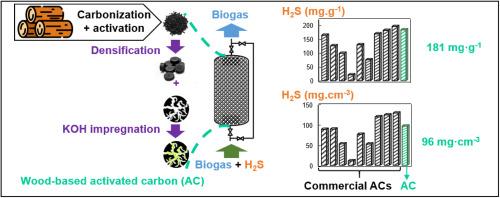Optimized wood-based activated charcoal for desulfurization under realistic biogas conditions
IF 11.6
2区 材料科学
Q1 CHEMISTRY, PHYSICAL
引用次数: 0
Abstract
This study focuses on the development of a high-performance activated carbon (AC) derived from wood-based charcoal for biogas desulfurization. ACs were densified with eco-friendly binders (cane molasses, beet molasses and plant polyphenols) and impregnated with KI, K2CO3, NaOH and KOH at loadings of 5–15 wt%. Both processes enhanced H2S separation capacity, evaluated through dynamic adsorption tests using a gas mixture composed of N2, CO2, O2 and H2S, simulating realistic biogas conditions. The best-performing sorbent, AC densified with polyphenol-based binder and impregnated with 10 wt% KOH, was compared to commercial ACs used for biogas desulfurization under identical testing conditions. The developed AC achieved a high H2S separation capacity of 181 mg g−1 and a competitive volumetric performance of 96 mg cm−3, demonstrating strong potential for industrial application. A 1D model for simulating breakthrough curves was developed and validated, using densified AC with CO2 and O2 in the feed gas. The model provides accurate predictions and mass transfer coefficients, supporting process design and material optimization. Thermal regeneration at 500 °C under N2 allowed approximately 50 % of the initial performance to be recovered indicating the need for improved regeneration strategies. The results demonstrate the potential of sustainable, wood-derived AC as a competitive sorbent for industrial biogas purification.

优化木质活性炭在真实沼气条件下的脱硫效果
本研究的重点是开发一种用于沼气脱硫的高性能活性炭(AC)。ACs用环保型粘合剂(甘蔗糖蜜、甜菜糖蜜和植物多酚)进行致密化,并在5-15 wt%的负荷下用KI、K2CO3、NaOH和KOH浸渍。这两种工艺都提高了H2S的分离能力,通过模拟真实沼气条件,使用由N2、CO2、O2和H2S组成的气体混合物进行动态吸附测试来评估。在相同的测试条件下,将性能最好的吸附剂AC与用于沼气脱硫的商业AC进行了比较,该吸附剂是用多酚基粘合剂致密化并浸渍10 wt% KOH。所开发的AC具有181 mg g−1的高H2S分离容量和96 mg cm−3的竞争性体积性能,具有很强的工业应用潜力。开发并验证了一个一维模型,用于模拟突破曲线,使用致密的AC,在原料气中含有CO2和O2。该模型提供了准确的预测和传质系数,支持工艺设计和材料优化。在500°C的N2条件下进行热再生,可以恢复大约50%的初始性能,这表明需要改进再生策略。结果表明,可持续的,木材衍生的AC作为工业沼气净化的有竞争力的吸附剂的潜力。
本文章由计算机程序翻译,如有差异,请以英文原文为准。
求助全文
约1分钟内获得全文
求助全文
来源期刊

Carbon
工程技术-材料科学:综合
CiteScore
20.80
自引率
7.30%
发文量
0
审稿时长
23 days
期刊介绍:
The journal Carbon is an international multidisciplinary forum for communicating scientific advances in the field of carbon materials. It reports new findings related to the formation, structure, properties, behaviors, and technological applications of carbons. Carbons are a broad class of ordered or disordered solid phases composed primarily of elemental carbon, including but not limited to carbon black, carbon fibers and filaments, carbon nanotubes, diamond and diamond-like carbon, fullerenes, glassy carbon, graphite, graphene, graphene-oxide, porous carbons, pyrolytic carbon, and other sp2 and non-sp2 hybridized carbon systems. Carbon is the companion title to the open access journal Carbon Trends. Relevant application areas for carbon materials include biology and medicine, catalysis, electronic, optoelectronic, spintronic, high-frequency, and photonic devices, energy storage and conversion systems, environmental applications and water treatment, smart materials and systems, and structural and thermal applications.
 求助内容:
求助内容: 应助结果提醒方式:
应助结果提醒方式:


